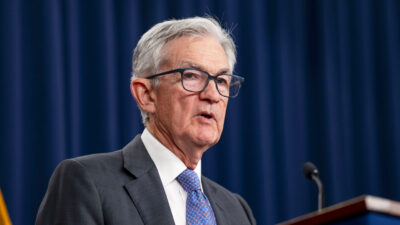Strong Jobs Report Joins “Hard Data” Showing US Economy Weathering Tariff Tumult
A stronger than expected jobs report was the latest economic measurement to reveal a chasm between so-called hard and soft data points.

Sign up for smart news, insights, and analysis on the biggest financial stories of the day.
The American economy keeps making like Bruce Willis in Die Hard. The Labor Department’s Bureau of Labor Statistics reported Friday that nonfarm payrolls increased by 177,000 jobs in April, besting forecasts and offering the latest hard data point showing economic resiliency in the face of tariff-induced turmoil.
And yet the data that measures economic sentiment continues to tell a different story: pending gloom. As The Smiths song goes: “I was looking for a job, and then I found a job and heaven knows I’m miserable now.”
The Hard and the Soft Truth
In the wake of President Trump’s tariff announcements last month, much of the economic discussion has hinged on so-called hard and soft data. Hard data, simply put, are the measurements collected from economic activity like sales, job postings and manufacturing output. Soft data refers to something far less quantifiable but nevertheless important: temperature-taking via surveys of businesses and consumers.
A fair amount of US economic hard data — like consumer spending, a 3% rise in core GDP last quarter, and this latest jobs report — have suggested the economy is holding up despite broad uncertainty about global trade in the short to medium term. The strong labor market data also boosted the ever-patient Federal Reserve’s delaying interest rate cuts until policymakers have a clearer picture of what tariffs might do to the economy. Goldman Sachs and Barclays both said they expect the Federal Reserve to cut its benchmark interest rate in July now, after previously forecasting a reduction in June. The soft data, meanwhile, is telling a different story:
- Consumer and business sentiment continues to slump: Last week delivered the lowest reading on the Conference Board’s Consumer Confidence Index since 2011 while the Institute for Supply Management’s manufacturing PMI hit a five-month low of 48.7, in the sub-50 territory that suggests the manufacturing sector contracted in April. Economists are worried the data could point to future layoffs, while companies from carmaker General Motors to confectionary giant Hersheys have told investors that tariffs will eat into their bottom lines.
- On the upside, one of the key exacerbators of the trade war anxiety driving these sentiments softened Friday. China’s Commerce Ministry said it is “evaluating” an offer from Washington to start negotiations, the same day the so-called de minimis exemption of duties on packages worth under $800 from Hong Kong or China ended, exposing a wide swath of goods to 145% tariffs.
Stock Rebound: If markets are your indicator, the S&P 500 was up for the ninth consecutive day on Friday, and the 10% gain over that period brought the index approximately level with where it was before a selloff inspired by Trump’s April 2 tariff announcement. The 90-day pause on tariffs expires July 8, so those investors who jumped off the sidelines this week might still want to buy a grill early in case future Independence Days become more expensive.











